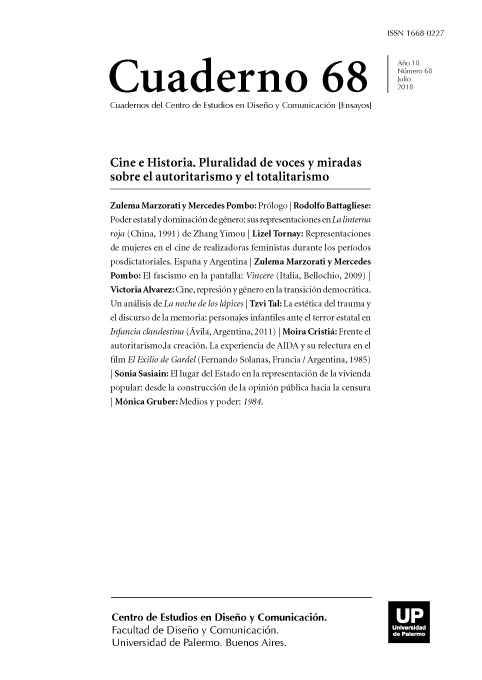Frente el autoritarismo,la creación. La experiencia de AIDA y su relectura en el film El Exilio de Gardel (Fernando Solanas, Francia /Argentina, 1985)
Abstract
In October 1979, a group of French and foreign artists and intellectuals headed by theater director Ariane Mnouchkine created AIDA (Association Internationale de défense des artistes victimes de la répression dans le monde), with the aim of denouncing censorship and violations of Human Rights of artists in different countries. The Association proposed creative actions, in order to exert international pressure on the victimization regimes. Founded in Paris, AIDA was deployed in several french cities, in other european countries and in the United States, using member networks to articulate actions. The case of the repression of the Argentine dictatorship deserved an important campaign of repudiation, boosted by the presence of some argentine exiles in the executive committee of the association. Under the title One hundred argentine artists who disappeared, a series of demonstrations of solidarity were coordinated in different cities, including marches, paintings and postcards, as well as a book on cultural repression in Argentina published in Paris, and shortly afterwards in Madrid. The biggest manifestation of AIDA of this campaign, a particular march in Paris on November 14, 1981, was filmed, among others, by argentine filmmaker Fernando Solanas, an active member of the Association. The experience of exile, and of AIDA in particular, appear as raw material of his fiction film The Exile of Gardel (El Exilio de Gardel, 1985), as well as the images captured on that day are incorporated into the film. Based on little explored archives (written and visual documents, correspondence), press and interviews, this article will try to outline the action taken by AIDA and analyze the way in which Fernando Solanas built his work reelaborating the memory of his experience in the Association. The study of this film will allow to collaborate, from an empirical analysis, to the reflection and theorization on the function of creation as a space of resistance, of action in the transnational public sphere and of memory of personal and collective life experiences.
References
Buch, E. (2016). Música, dictadura, resistencia. La orquesta de París en Buenos Aires, 1980. Buenos Aires: FCE.
Bruzzone, G. y Longoni, A. (dir.) (2008). El siluetazo. Buenos Aires: Adriana Hidalgo Editora.
Catela, L.(2009). “Lo invisible revelado. El uso de fotografías como (re) presentación de la desaparición de personas en Argentina”, en Feld, C. y Stites Mor, J. (Comp.), El pasado que miramos. Buenos Aires: Paidós, p. 337-361.
Cristiá, M. (2016). Imaginaire péroniste. Esthétique d’un discours politique. Rennes: Presses Universitaires de Rennes.
Del Valle Dávila, I. (2015). Le nouveau cinéma latino-américain (1960-1974). Rennes: Presses Universitaires de Rennes.
Franco, M. (2008). El exilio. Argentinos en Francia durante la dictadura. Buenos Aires: Siglo XXI.
Fraser, N. et al.(2014). Transnacionalizing the Public Sphere. Cambridge: Polity Press.
Gorini, U. (2006). La rebelión de las Madres, tomo 1. Buenos Aires: Norma.
Hage, J. (2010). Feltrinelli, Maspero, Wagenbach: une nouvelle génération d’éditeurs politiques d’extrême gauche en Europe occidentale, 1955-1982. Histoire comparée, histoire croisée, Tesis de Doctorado dirigida por M. Jean-Yves Mollier, Université de Versailles - SaintQuentin-en-Yvelines.
Jensen, S. (2005). “Del viaje no deseado al viaje de retorno. Representaciones del exilio en Libro de Navíos y Borrascas y Tangos. El exilio de Gardel”, en Jelin, E. y Longoni, A. (comp.), Escrituras, imágenes y escenarios ante la represión. Buenos Aires: Siglo XXI editores, p. 167-202.
Jelin, E. (2002). Los trabajos de la memoria. Buenos Aires: Siglo XXI Editores.
Longoni, A. (2010). “Fotos y siluetas: dos estrategias en la representación de los desaparecidos”, en Crenzel, E. (comp.), Los desaparecidos en la Argentina. Memorias, representaciones e ideas (1983-2008), Buenos Aires: Biblos.
Longoni, A. (2010). “Fotos y siluetas: políticas visuales en el movimiento de derechos humanos en Argentina”, Afterall journal, p. 5-17.
Mestman, M. (Ed.) (2014). Estados generales del Tercer Cine. Los documentos de Montreal. 1974. Buenos Aires: Prometeo / REHIME n°3, año 3.
Moine, C.n(2015). “Votre combat est le nôtre”. Les mouvements de solidarité internationale avec le Chili dans l’Europe de la Guerre froide, Monde(s), vol. 2, n° 8, p. 83-104.
Monteagudo, L. (1993). Fernando Solanas. Buenos Aires: CEAL.
Patterson, A. (2013). Music & Second Culture Post Millennium. Portland: Eurock.
Stites Mor, J. (2012). Transition Cinema: Political Filmmaking and the Argentine Left since 1968. Pittsburgh: University of Pittsburgh Press.
Stites Mor, J. (ed.) (2013). Human Rights and Transnational Solidarity in Cold War Latin America. Madison: University of Wiscosin Press.
Los autores/as que publiquen en esta revista ceden los derechos de autor y de publicación a "Cuadernos del Centro de Estudios de Diseño y Comunicación", Aceptando el registro de su trabajo bajo una licencia de atribución de Creative Commons, que permite a terceros utilizar lo publicado siempre que de el crédito pertinente a los autores y a esta revista.


